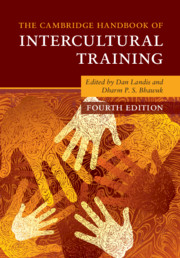Book contents
- The Cambridge Handbook of Intercultural Training
- Reviews
- The Cambridge Handbook of Intercultural Training
- Copyright page
- Dedication
- Frontispiece
- Contents
- Figures
- Tables
- Editors and Contributors
- Foreword
- Preface
- 1 Introduction and Theoretical Framework
- Part I Theoretical Foundations of Intercultural Training
- Part II Practice of Intercultural Training
- 10 International Initiatives in K–12 and Higher Education
- 11 The Triad Training Model in Counseling, Cultural Diversity, and Intercultural Training
- 12 Multicultural Counseling Training and Intercultural Training
- 13 Training for Cross-Cultural Competence in the United States Military
- 14 Developing Intercultural Competency Training in Global Organizations
- Part III Indigenous Psychology and Intercultural Training
- Part IV New Interdisciplinary Approaches to Intercultural Training
- Part V Summing Up
- Index
- References
14 - Developing Intercultural Competency Training in Global Organizations
An Examination of the Cadre of Global Managers
from Part II - Practice of Intercultural Training
Published online by Cambridge University Press: 18 September 2020
- The Cambridge Handbook of Intercultural Training
- Reviews
- The Cambridge Handbook of Intercultural Training
- Copyright page
- Dedication
- Frontispiece
- Contents
- Figures
- Tables
- Editors and Contributors
- Foreword
- Preface
- 1 Introduction and Theoretical Framework
- Part I Theoretical Foundations of Intercultural Training
- Part II Practice of Intercultural Training
- 10 International Initiatives in K–12 and Higher Education
- 11 The Triad Training Model in Counseling, Cultural Diversity, and Intercultural Training
- 12 Multicultural Counseling Training and Intercultural Training
- 13 Training for Cross-Cultural Competence in the United States Military
- 14 Developing Intercultural Competency Training in Global Organizations
- Part III Indigenous Psychology and Intercultural Training
- Part IV New Interdisciplinary Approaches to Intercultural Training
- Part V Summing Up
- Index
- References
Summary
Global organizations demand a heterogeneous global talent pool. For decades, this talent pool has been dominated by what we consider traditional “there-and-back” expatriates, overseas assignees who are transferred to a host-country for three to four years and subsequently return to the home-country organization. To accommodate the pressures of globalization, it is argued that organizations today would benefit from a more dynamic talent pool which is composed of a cadre of managers that includes but also goes beyond the traditional expatriate. We speak of the global manager “family” which in addition to expatriates includes flexpatriates and inpatriates. Together these complimentary pools of talent help to facilitate the development of a global mindset among global managers that is necessary to compete beyond domestic borders. The mix of managers differs greatly relative to the duration of assignments, destinations, number of destinations, and commitment to the organization and career. As a result, we argue that each manager requires a combination of intercultural competencies or a “tool set” to reflect the demands of the assignment type which allows them to be successful in their roles. This chapter draws on a competency-based view to form the basis of the critical elements for building intercultural competency in global managers.
- Type
- Chapter
- Information
- The Cambridge Handbook of Intercultural Training , pp. 475 - 494Publisher: Cambridge University PressPrint publication year: 2020



